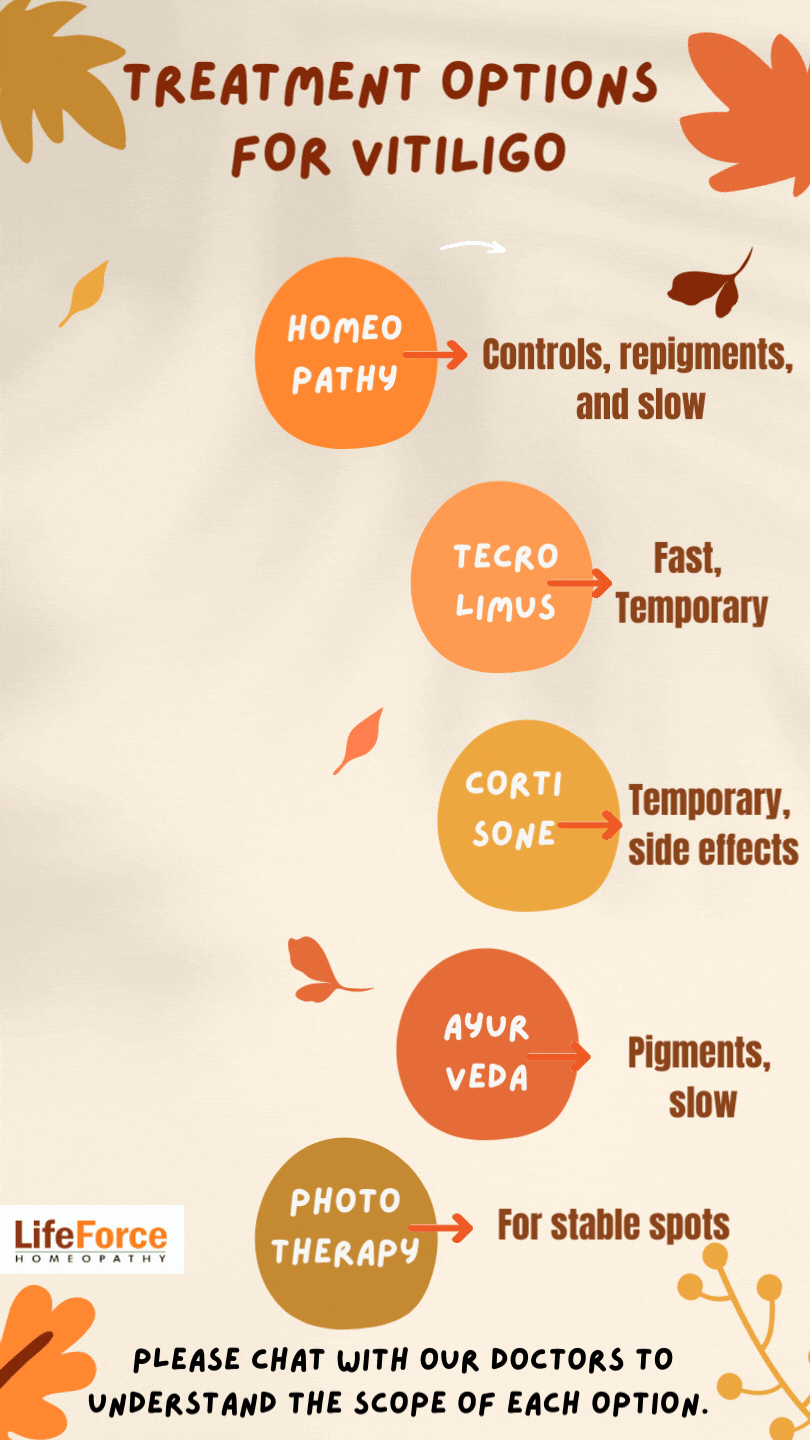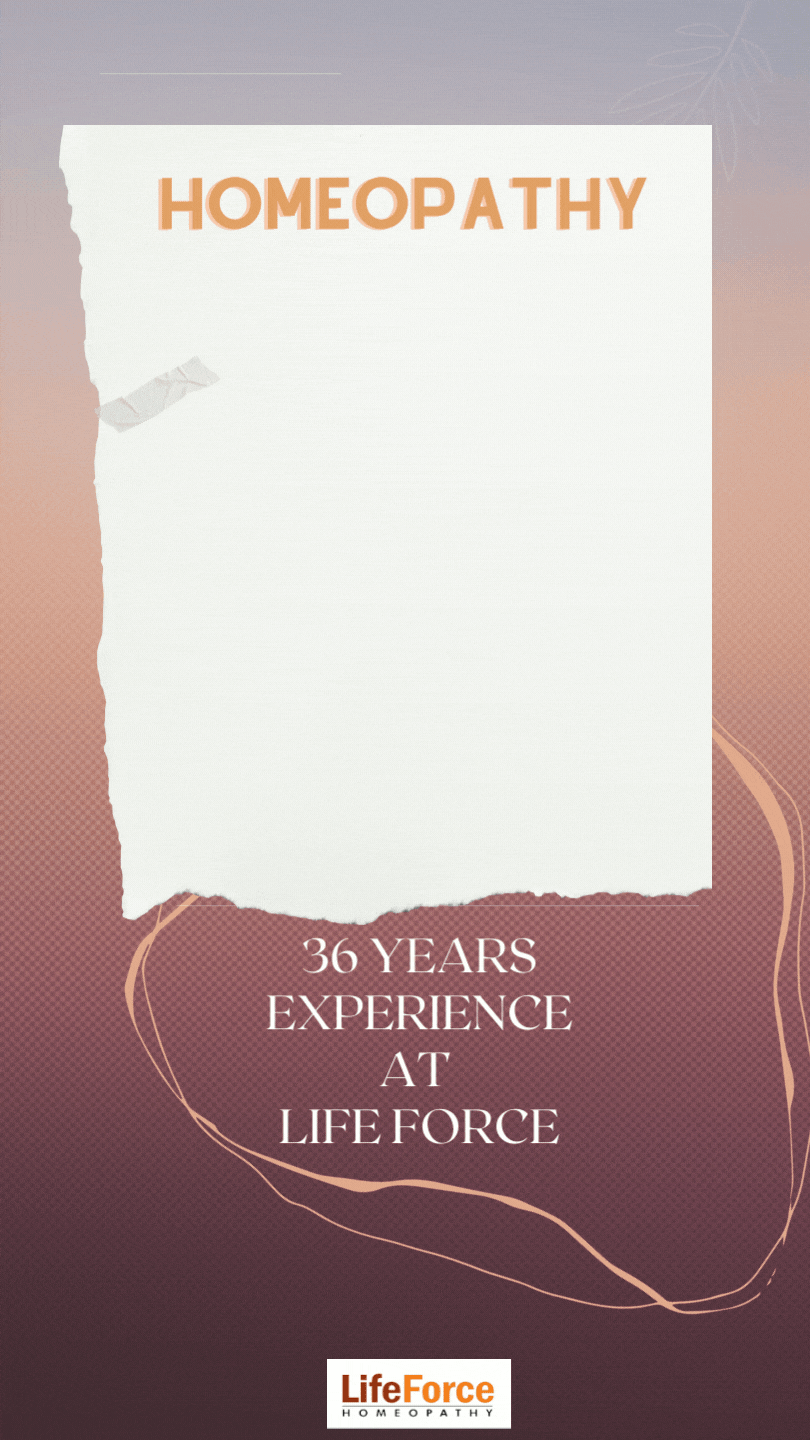Types of treatment for Vitiligo
There are various modalities of vitiligo treatment available under different systems of medicine.
- Homeopathic treatment
- Conventional treatment
- Ayurvedic (herbal) treatment
- Surgical treatment
 Homeopathic treatment
Homeopathic treatment
This website talks in length about the Homeopathic approach to the management of vitiligo. Homeopathy, by far is among the best possible options for vitiligo. It helps immensely to control the spread of the disease as well as re-pigment many cases if not all. More information may be explored on these pages.
Conventional Treatment for Vitiligo
The main goal of vitiligo treatment is to improve and enhance melanin formation on white patches. Each patient responds differently to the treatment, and a particular treatment may not work for everyone. There is no ideal treatment in the absence of a clear understanding of the cause of vitiligo. The conventional treatment can be divided into the following:
- General Aspects
- Medical Treatment
General Aspects
Vitiligo has an unpredictable course and its prognosis may not always be encouraging. Patients need to maintain good general health and a balanced nutritious diet enriched with adequate proteins, vitamins B-complex and E, and minerals, such as copper, zinc, and iron.
One must avoid physical, chemical, and emotional trauma as far as possible. One must also avoid the use of soaps and detergents containing phenolic compounds, rubber goods, and contact with or exposure to other chemical agents known to affect melanogenesis.
Medical Treatment
The type of treatment selected depends on the type of vitiligo, its severity, as well as the patient’s preference, health, and age. Medical treatment of vitiligo comprises the following:
Psoralen Compounds and UVA Therapy
Psoralen is one of the most effective of all drugs. It contains chemicals (furocoumarin compounds) that react with ultraviolet light (photosensitizing chemicals) to cause the darkening of the skin. However, it is time-consuming, and care must be taken to avoid the side effects, which can sometimes be severe.
Ask your questions to Dr Shah's team directly & get an expert opinion on your ailment!
 Topical PUVA Therapy
Topical PUVA Therapy
Topical psoralen photochemotherapy is often used for individuals with a small number of depigmented patches affecting a limited part of the body and for children aged 2 years and older, who have localized patches of vitiligo.
Oral PUVA Therapy
Oral PUVA therapy is used as vitiligo treatment for individuals with extensive vitiligo (leucoderma) (affecting more than 20% of the body) or for those who do not respond to topical PUVA therapy. Oral psoralen is not recommended for children under 10 years of age because it increases the risk of damage to the eyes caused by conditions such as cataracts.
UVB Phototherapy
Narrowband UVB therapy is more effective in re-pigmentation than PUVA therapy. It targets specific small lesions. Selective narrow-band UV-B (311 nm) is used with a fibre optic system to direct radiation to specific areas of the skin.
Excimer Laser
The 308-nm xenon chloride excimer laser is an efficacious, safe, and well-tolerated vitiligo treatment for chronic stable vitiligo (leucoderma) limited to less than 30% of the body surface. It acts through immunomodulation by affecting T cells. Treatment periods of more than 12 weeks may be necessary to obtain satisfactory results.
Topical Therapy
Topical therapy is used in vitiligo treatment. Topical agents like methoxsalen, trioxsalen, corticosteroids, and calcineurin inhibitors are used in this therapy. Though it’s used prominently for treating vitiligo, it has a few side effects.
Ask your questions to Dr Shah's team directly & get an expert opinion on your ailment!
Surgical treatment for vitiligo
All surgical therapies must be considered only after proper medical therapy has been attempted. These vitiligo treatment regimens are often indicated in segmental or localized and stable vitiligo. Areas such as dorsal fingers, ankles, forehead, and hairline tend to not re-pigment well. Carefully selected patients who have small areas of vitiligo with stable activity are candidates suitable for surgical transplants. Surgical techniques are time-consuming and expensive and usually not paid for by insurance carriers.
Surgical modalities include
Autologous skin grafts:
In this procedure, the skin from one area of the patient’s body is removed and attached to another area. This type of skin grafting is sometimes used for patients with small patches of vitiligo. Treatment with grafting takes time and is costly, and many people find it neither acceptable nor affordable.
Skin grafts using blisters
In this procedure, the blisters are created on the patient’s pigmented skin by using heat, suction, or freezing cold. The tops of the blisters are then cut out and transplanted to a depigmented skin area. The risks of blister grafting include scarring and lack of re-pigmentation. However, there is less risk of scarring with this procedure than with other types of grafting.
Punch mini-grafting
In this procedure, small-donor grafts are inserted into the incision of recipient sites and held in place by a pressure dressing. The graft heals readily and begins to show repigmentation within 4-6 weeks. Some pebbling persists but it’s minimal, and the cosmetic result is excellent.
Micro-pigmentation (Tattooing)
This procedure involves implanting pigment into the skin with a special surgical instrument. It works best for the lip area, particularly in people with dark skin.
Ayurvedic (herbal) Treatment for Vitiligo
Ayurveda is a Sanskrit term meaning ‘science of life’. Ayurveda perceives life as the union of body, mind, senses, and soul. ‘Charaka Samhita’, a 2000-year-old Indian Ayurvedic text, describes vitiligo as ‘Svitra’ or ‘Kilasa’, with recommendations for vitiligo treatment.
Some Ayurvedic physicians recommend raktamoksha (therapeutic bloodletting), either by topical application of leeches to affected areas or by using a syringe or surgical knife, from the affected skin patches, as part of the therapy. This method is used to remove excess pitta dosha in the rakta dhatu.
Ayurvedic Medicines for vitiligo: Arogya Vardhini, Trivanga Bhasma, Mahamanjishthadi Qadha (decoction) & Khadirarishta are the most commonly used traditional ayurvedic medicines for vitiligo treatment.
Herbal medicines useful for vitiligo: Manjishtha (Rubia cordifolia), Saariva (Hemidesmus indicus), Triphala (Three fruits), Haridra (Curcuma longa), Daruharidra (Berberis aristata), Khadir (Acacia catechu), Vidanga (Embilia ribes), and Bavachi (Psoralia corylifolia) provide your effective vitiligo treatment.
Ask your questions to Dr Shah's team directly & get an expert opinion on your ailment!
Homeopathic Treatment for Vitiligo
Vitiligo treatment in Mumbai: The homeopathic approach to treating any disease is based on the philosophy of augmenting the body’s own healing processes. This is achieved by administering medicine, which has the capacity to correct the altered immunity that led to the development of the disease.
Also Read: Vitiligo Treatment
Incredible Benefits Of Homeopathy For Vitiligo
Some of the advantages of vitiligo treatment with homeopathy are as below.
- First, homeopathy works to curb the progression of vitiligo.
- The second phase of vitiligo treatment with homeopathy focuses on regaining the normal colour of the skin which has turned white.
- Homeopathy goes deeper and focuses on treating the root cause of vitiligo which promotes a wonderful recovery.
- The vitiligo treatment with homeopathy moderates your overactive immune system thus curbing the destruction of melanocytes in the skin.
- Homeopathic medicines for vitiligo are derived from natural sources so100% safe and highly effective.
- Homeopathy gifts you long-lasting results.
3 Effective Health Tips For Vitiligo To Follow
During vitiligo treatment, you need to follow certain effective healthcare tips for quick results.
1. Protect Your Skin From Cuts
When suffering from vitiligo, you need to avoid skin trauma. Even a small abrasion or skin cut can cause bleeding and pain as well as increase the risk of the development of vitiligo in that area.
2. Drink Water Stored In Copper Vessel
Drinking water that is long stored in a copper vessel regularly offers you quick results in recovery from vitiligo. It helps boost melanin production in your body which in turn reduces the whiteness of the affected skin.
3. Eat Raw Cucumber
Eating about 600 grams of fresh raw cucumber thrice every day while continuing your vitiligo treatment can help you get rid of vitiligo issues in a couple of months. Also, you need to follow a vegetarian diet strictly. Also, along with raw cucumber, you can eat three beetle leaves thrice daily to witness a significant reduction in white skin patches.
Related Article: Role of a diet in vitiligo
Side-Effects Of Other Treatments
Vitiligo treatment with homeopathy is completely safe and does not cause any side effects. However, various other treatments for vitiligo can have side effects as below.
Creams
Creams that regulate inflammation can cause side effects, such as the occurrence of lines on your skin and skin thinning.
Form of Vitamin D
Topical Dovonex can cause itching, dry skin, and rashes.
Psoralen and Light Therapy
A combination of psoralen and light therapy can cause over-darkening of skin, intense sunburn, itching, blisters, and a high risk of skin cancer and cataracts.
Laser Therapy
It causes side effects like blistering and redness.
Depigmentation
Side effects of depigmentation by using monobenzone are swelling, dry skin, redness, and itching.
Ask your questions to Dr. Shah's team directly & get an expert opinion on your ailment!